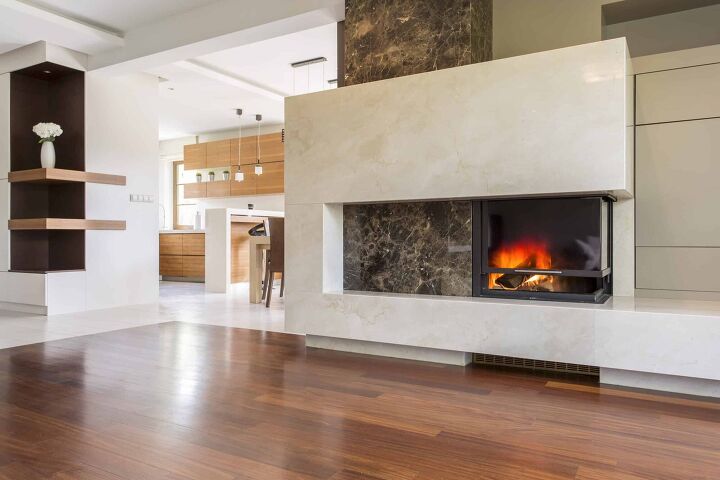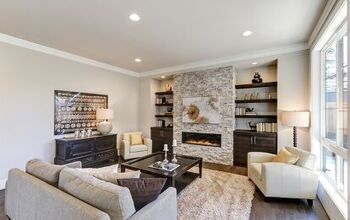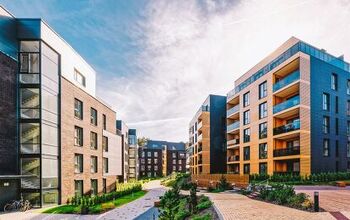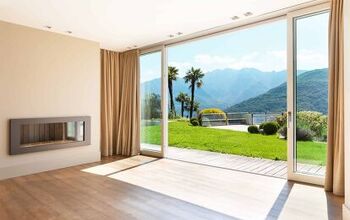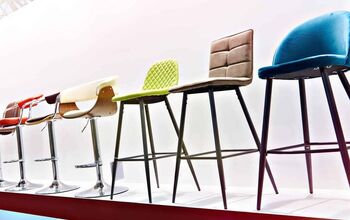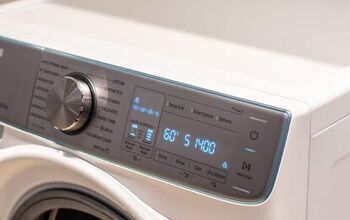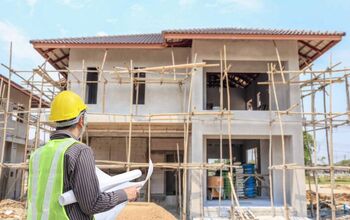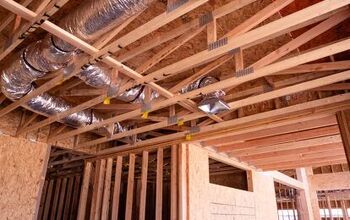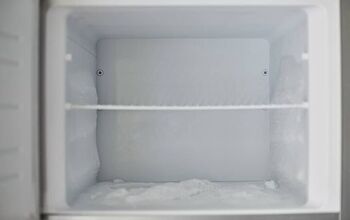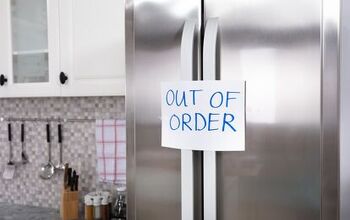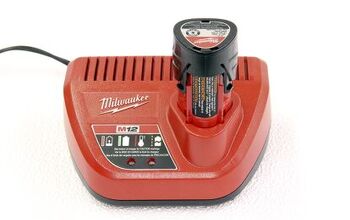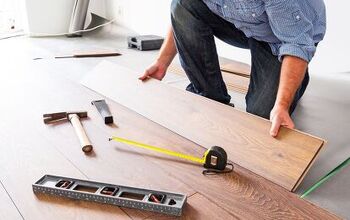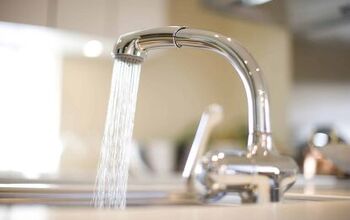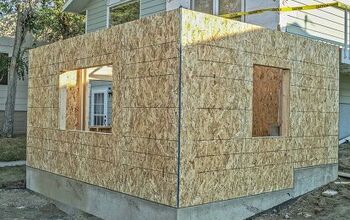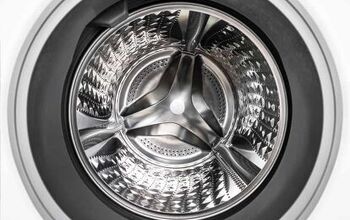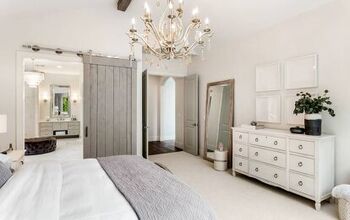20+Different Types of Fireplaces (with Photos)

Throughout history, fireplaces have served as a focal point in many homes across the world. They provide light, heat, a central area for entertaining or relaxing, and even offer a place to make a hot meal. Installing a fireplace in your home is a wonderful way to create a cozy atmosphere. For many folks, something as simple as a fireplace brings about very nostalgic emotions, reminiscent of holidays and times spent with family and friends.
Over the past several decades, fireplaces have come a long way. No longer are you limited to traditional wood-burning fireplaces, with some of the most common types of fireplaces nowadays ranging from gas and electric to gel and ethanol. However, the sheer number of options when it comes to fireplaces can be very overwhelming to navigate.
Fortunately, we’ve put together a comprehensive guide on fireplaces to help guide you in your search. With that said, let’s dive right in and take a look at over 20 different types of fireplaces you have to choose from.
Do You Need Brick and Stone Fireplace Installers?
Get free, zero-commitment quotes from pro contractors near you.

Types of Fireplaces
In order to make an informed decision when purchasing a fireplace, you need to be aware of all the major choices to be made. Beginning with fuel type, we’ll explore all of the fireplace variations including mounting style, size, materials, and more.
Fireplaces Based on Fuel Type
The first decision that you must make when purchasing a fireplace is the type of fuel. Fuel type is often dictated by what is available in your particular area. This choice will also determine the overall design of the fireplace and your mounting options.
When it comes to fireplaces, the main fuel types available to you are electric, gas, wood, gel, and ethanol.
1. Electric Fireplace
Electric fireplaces are a very popular, easy-to-install choice and also one of the most cost-effective types of fireplaces. They produce warmth by heating coils inside, and most models feature a fan for dispersing the heat throughout your home. Similar to a large space heater, electric fireplaces get power by being plugged into the wall.
Instead of having a real flame, electric fireplaces typically feature a ‘fake’ flame to help achieve that classic fireplace look. LED lights are used to create genuine-looking imitation flames that are projected onto a screen. In some cases, the ‘fake’ flame will be paired with an artificial log to produce even more of that nostalgic fireplace appearance.
Or, some models even give you the option to adjust the look of the flame (including changing the color) or create additional optical effects to complement the décor in your living space.
Many of the early electric fireplace models weren’t all that appealing. Fortunately, modern models are much more aesthetically pleasing, with the goal to resemble a traditional wood-burning fireplace. Some higher-end models allow you to connect to Bluetooth speakers, Wi-Fi, or even have an app to control your electric fireplace from the convenience of your mobile device.
Others will come with built-in thermostats or a simple remote control for adjusting the temperature without having to get up and make the changes on the device itself.
Most electric fireplace models can heat an area up to 500 feet, while hardwired models can service more than 1000 square feet. This type of fireplace is the ideal choice if you’re looking to heat your home on a budget. They are relatively affordable to operate, come with low maintenance costs, and are cheaper to install due to their lack of need for a venting system. As an added bonus, if you have kids or pets, you won’t have to worry about them coming into contact with ‘real’ flames.
Infrared FireplacesA relatively new type of electric fireplace that’s on the market is an infrared fireplace. These fireplaces differ from standard electric fireplaces in that they operate based on a quartz heating technology. Instead of heating coils, infrared fireplaces use infrared to heat the surface of objects – a form of radiant heating. They function similar to an infrared sauna.
Similar to other traditional electric fireplaces, most infrared versions let you switch between visual effects, and come with a built-in thermostat to adjust the heat or let the device run without emitting any heat at all.
2. Gas Fireplace
While they may be less natural and visually pleasing than traditional wood-burning fireplaces, gas fireplaces are another very popular option. They are very common among new constructions, because of their safety, efficiency, and relatively low installation costs. Oftentimes, you can insert a gas fireplace into an existing chimney or fireplace of another type.
Aside from lower upfront costs, gas fireplaces are very efficient when you have a gas line already in place in your home. This means you can enjoy significantly lower heating bills when you opt for a gas fireplace. Your gas fireplace will either run on propane or natural gas. The biggest differences between the two has to do with safety pilot options and the burner cavities.
For instance, a liquid propane gas burner cannot be lit with a lighter or a match. Since liquid propane is heavier than air, the burner must remain closed tight with a manual valve or gas might escape into the room and cause a fire hazard. Whereas, natural gas is lighter than air and the manual valve can be left slightly ajar without and risk of fire.
Generally speaking, gas fireplaces are found in three types: inserts, log sets, and built-ins.
- Inserts: An insert is a log and burner set that rests inside of a metal box, enclosed by a larger box, and installed into an existing fireplace. This option is ideal for those who want to retrofit an existing wood-burning fireplace to achieve something that is more energy-efficient and convenient. Inserts will either have a vent or vent-free exhaust system.
- Log Sets: Log sets are the most cost-effective gas fireplace option. They consist of ceramic logs and a gas burner, installed inside an existing fireplace. Some are ventless, while others will vent up your chimney.
- Built-Ins: While built-ins are made like inserts, they don’t require that you have an existing fireplace or chimney. Instead, the vent-free version will exhaust into the room and vented units will exhaust through an opening in an exterior wall.
Gas fireplaces can also be characterized based on their vent system. They may use either a direct vent, vent-free, or B-vent exhaust system. We’ll describe these three different variations in detail below.
Direct Vent Gas FireplacesA gas fireplace with a direct vent exhaust system uses air from the outside in the combustion process. All of the emissions are then released outside of the home in a completely sealed system. Direct vent gas fireplaces are the ideal choice for well-sealed homes, offering high efficiency. However, they do not only improve heating efficiency, direct vent systems also uphold indoor air quality.
These systems can operate without electricity, meaning they work great in areas that experience frequent power outages.
Vent-Free Gas FireplacesVent-Free, or ventless, gas fireplaces are usually open to the room that they are installed in. This means that they use the air within the home and also release emissions into the home. Since vent-free gas fireplaces are notoriously easy to install, they are incredibly popular. However, they do come with some drawbacks.
Being ventless, these systems result in poorer air quality and possible health concerns. Although they are very efficient, vent-free gas fireplaces are not suitable for primary home heating requirements. With that said, these systems are ideal for large rooms with high ceilings that have plenty of space to allow humidity and carbon dioxide to properly disperse.
Vent-free systems are characterized by their blue flame, as opposed to the direct vent variety that has a yellow flame.
B-Vent Gas FireplacesWith regard to operation and appearance, B-vent gas fireplaces are similar to wood-burning fireplaces. They, like ventless and open-hearth systems, are open to the room. However, unlike the latter, B-vent gas fireplaces use a gas burner and a valve system to create heat. The ‘B’ comes from the natural vent piping that these systems use instead of a traditional chimney.
Although these types of fireplaces tend to be very aesthetically pleasing, they don’t produce a considerable amount of heat. Therefore, B-vent gas fireplaces are the ideal option for warmer climates where décor is more important than heating ability.
3. Wood-Burning Fireplace
When you think of a fireplace, oftentimes, the wood-burning variety is what comes to mind. For many, there simply is no substitute for a wood-burning fireplace – especially for those who grew up with one in their home. When it comes to aesthetics, nothing compares to the visuals, crackling sound, and scent of a “real” fire.
There’re also many people who truly enjoy the process of splitting wood, building, and maintaining a fire. Regardless, if you love the nostalgia of a wood-burning fireplace, no other option will ever quite match up. With that said, there are some downsides to these types of fireplaces and reasons why they are becoming less popular.
More specifically, some of the drawbacks include efficiency, safety, and local and government regulations. Wood-burning fireplaces can also be expensive to install and require frequent professional cleanings. Not to mention, you’ll need to factor in either purchasing or chopping your own wood.
Despite the downsides, it’s unlikely that we’ll see wood-burning fireplaces completely disappear anytime soon. They are still popular and well-loved by many.
4. Pellet-Burning Fireplace
If most of the other options on this list don’t appeal to you, or you simply don’t have a good source of firewood, consider using wood pallets as the fuel for your fireplace. Pellet-burning options are available as fireplace inserts, enclosed zero-clearance fireplaces, and also stand-alone pellet stoves.
These types of systems require a specialized venting system, which will add to your overall installation costs. However, pellet-burning systems are not as difficult to install as a stovepipe or chimney. They require being plugged into a standard electrical outlet in order to operate the adjustment, ignition, and ventilation systems.
Depending on the model you have, your pellet stove may be manually loaded or have an automated loading system. It might also come with a thermostat, while some are programmable. Many pellet stoves are operated by a remote control, but there are others that offer the ability to be controlled via your cell phone or a mobile app.
Generally speaking, wood pellets burn more efficiently than both wood and gas, making them a very eco-friendly alternative. They are also made from entirely recycled materials such as sawdust, bark, or other wood byproducts. Not to mention, as little as 10% of the heat produced by pellet-burning fireplaces escapes out of the vent. This means that your pellet burning is a fraction of the cost of gas-based or traditional wood alternatives.
5. Gel Fireplace
Alcohol gel burning fireplaces are a relatively new addition to the variety of fireplace options you have to choose from. Though they are less popular, they offer an array of benefits. First, gel fireplaces are simple to install and all they require is a can of gel to refill and refuel the system.
Also, since gel fireplaces are self-contained and lightweight, they have the ability to be easily moved from room to room or mounted on a wall. They are aesthetically pleasing, modern in design, and produce a real flame. Though, the flame in a gel fireplace is slightly denser and flickers less than that of an ethanol-burning fireplace. Regardless, gel fireplaces only require a lighter to get the flame started.
The major downside to these types of fireplaces is that they don’t produce a significant amount of heat. You also cannot adjust the temperature, making gel fireplaces ideal for when you’re trying to achieve a particular look. These systems also don’t give off any smoke at all and because of the nature of the fuel, they cannot be left unattended. Should a gel fireplace get knocked over, you’ll be presented with a significant fire hazard.
6. Ethanol Fireplace
All types of ethanol fireplaces are ventless, meaning they offer a very convenient design and are easy to install. In most cases, you’ll find that they are compact and portable, allowing you to move them between rooms as desired. Visually, ethanol fireplaces are modern and contemporary, and are primarily for decorative purposes only.
Like gel fireplaces, ethanol fireplaces do not produce a substantial amount of heat. They still display and burn a real flame – one that flickers like a candle. While gel fireplaces don’t let you change the temperature, ethanol burners allow you to adjust the temperature up or down. Despite this, ethanol fireplaces are not efficient enough to warm an entire home.
You’ll find ethanol-burning fireplaces as wall-mounted units, fireplace inserts, and even tabletop variations.
Fireplaces Based on Mounting and Installation
Now that you understand your options relating to fuel type, let’s move on to explore all the ways that your fireplace can be mounted or installed. It’s important to keep in mind that not all mounting types will work with all fuel types. For example, a traditional wood-burning fireplace is far too big to be mounted on your living room wall.
With that said, the following are some of the most common fireplaces based on mounting and/or installation.
1. Traditional Open-Hearth Fireplace
An open-hearth fireplace is the traditional image of a fireplace that has persisted throughout history. This mounting style is used for wood-burning fireplaces, but you’ll often see other variations attempt to mimic a conventional open hearth. Often referred to as a masonry fireplace, open-hearth fireplaces consist of an open-faced fireproof box that is built directly into the wall of your home.
They are typically made of either stone or brick, and contain a chimney on the top for venting out the wood exhaust. The draw to traditional open hearth fireplaces is the fact that the fire is visible, which gives you the light, sound, aroma, and heat that folks love about wood-burning fires. “Hearth” denotes the bottom wall of the firebox, along with the protective brick or stone foundation in front of it that serves as a barrier between escaping embers and your flooring.
Most open-hearth fireplaces have a decorative façade, referred to as a mantle, and a shelf up top. The mantle might be constructed out of stone, brick, concrete, wood, adobe, or a variety of other materials. These types of fireplaces are best used by burning aged hardwood, which burns hotter, longer, and results in less tar collection in the flue than its softwood counterpart. Or, manufactured wood logs, that are comprised of wood chips and sawdust, can serve as an excellent alternative.
While they may be aesthetically pleasing, open-hearth fireplaces are very inefficient and can be dangerous if left unattended. The major concerns with these types of fireplaces are embers, creosote, and emissions.
2. Wall-Mounted Fireplace
Wall-mounted fireplaces are an excellent choice for small homes, condos, apartments, and outdoor entertainment spaces. Generally speaking, you’ll come across two types of wall-mounted fireplaces in your search. The first option requires the fireplace to be connected to a chimney, while the second does not. Which type depends on the fuel type you prefer and select.
These fireplaces can be found in a range of styles, sizes, and shapes. Most self-contained fireplaces even allow you to move the unit from room to room, as needed. Oftentimes, the reason for purchasing a wall-mounted fireplace is less about warmth and more about creating a focal point in your living space. It can also serve as an excellent centerpiece, especially if your living room lacks an entertainment center.
3. Free-Standing Fireplace
Free-standing fireplaces can serve as a great alternative to the conventional open hearth or wall-mounted styles. They can either mimic the traditional style and be placed on the wall, or look similar to the one above and be able to be moved around the room. Depending on the fuel type, your free-standing fireplace will entirely free-standing or attached to the ceiling or wall for ventilation purposes.
The electric free-standing models don’t require ventilation, which allows you to move them around the space effortlessly. Whereas, gas free-standing fireplaces generally need to stay in place when installed to allow for safe and proper ventilation. Free-standing fireplaces come in a number of styles, ranging from rustic to modern to contemporary. They’re also available in various sizes and shapes, to fit the décor of your space.
It’s very common to see free-standing fireplaces paired with entertainment centers, with the television being mounted above them. Or, you might find an entertainment center that comes with a built-in fireplace, ideal for those who live in apartments or homes with limited square footage.
4. Wood-Burning Stove
Though not technically a fireplace, a wood-burning stove is a great alternative that still preserves much of the nostalgia of burning wood in a traditional open-hearth fireplace. It is a free-standing unit made of either solid steel or cast iron, with a metal stove pipe for venting out exhaust. They are considerably more efficient than open-hearth fireplaces and are even regulated and labeled for efficiency by the Environmental Protection Agency (EPA).
Wood-burning stoves require much less firewood to produce sufficient heat. In fact, wood stoves are a completely practical method for meeting the daily heating needs of most homes, even in incredibly harsh weather conditions. Depending on the model, your wood-burning stove will be either catalytic or non-catalytic. The former means that the unit has a honeycomb-like feature called a catalyst that is made out of coated ceramics and collects all the smoke, gases, and other particles.
Once the exhaust particles pass through the honeycomb structure they burn up, which increases the efficiency of the woodstove and helps it maintain a more consistent output of heat. Another benefit of wood-burning stoves is that they are considered safer than conventional open fireplaces. All of the embers are contained inside the unit, and the box latches to keep everything out of reach of pets and children.
Additionally, their efficiency causes them to produce far less smoke and due to their enclosed nature, wood-burning stoves release less air pollution into your home. The only significant downside is that wood stoves must be cleaned, inspected, and maintained on a regular basis, which includes replacing the catalyst when needed.
5. Fireplace Inserts
A fireplace insert is the ideal choice for those who have a traditional open-hearth fireplace that they love but are tired of all the hassles that come along with it. This alternative allows you to literally insert a fireplace that uses gas, gel, or ethanol into an existing fireplace. By installing a fireplace insert you’ll have greatly improved the efficiency, safety, and overall heat-generating capacity of your fireplace.
Put simply, a fireplace insert is a closed-combustion firebox that is installed by inserting it into the masonry firebox of a traditional open-hearth fireplace. To improve heat dispersal and efficiency, fireplace inserts use an electric blower. The box is usually made out of steel or cast iron, like wood stoves, with glass doors on the front to keep the fire contained but also visible.
Arguably, the most beneficial thing about fireplace inserts is that they repurpose your current space. You can take advantage of traditional aesthetics or choose a completely different model with a more contemporary spin.
6. Hanging Fireplace
If you’re looking to infuse the perfect modern and contemporary vibe into your living space, a hanging fireplace is a great choice. They also look very futuristic, with many of them being shaped like a spaceship attached to your ceiling. Hanging fireplaces are relatively unobtrusive and hang from your ceiling via their vent pipe.
However, if you’re not into the modern look for your fireplace, you’ll likely want to consider a different option.
7. Tabletop Fireplace
Tabletop fireplaces are an excellent option if you’re looking to give your living space a focal point but may be limited on space. They come in a variety of smaller sizes but most are compact, lightweight, and can easily be moved from room to room or put away when not in use. In most cases, they are fueled by either ethanol or gel. Tabletop fireplaces can be found in both indoor and outdoor models.
8. Two-Sided Fireplace
With a two-sided fireplace, you can enjoy warmth and beauty in multiple rooms at the same time. Oftentimes, these types of fireplaces are installed between a dining room and living room, but they can also be used in bedrooms as a way to section off the sleeping space from a sitting area.
Regardless, two-sided fireplaces are a very modern design and will add a sense of luxury and sophistication to any home.
9. Outdoor Fireplaces and Fire Pits
While fireplaces installed indoors are most common, they do not have to be restricted to the inside of your home. An outdoor fireplace or fire pit can create a warm and cozy atmosphere for outdoor gatherings, especially now that most indoor gatherings are discouraged. If you’re limited on space in your home but still want a fireplace, consider installing one outside.
Believe it or not, constructing an outdoor fireplace is actually cheaper than building one inside. Additionally, many jurisdictions are pretty strict on indoor fireplaces, but much more lenient when it comes to the outdoor variety. However, make sure that you check with the local laws in your area prior to construction either an indoor or outdoor fireplace.
When it comes to outdoor fireplaces, there’s a wide array of options to choose from, many of which can be purchased as an easy-to-install kit. Other options include fire pits, which are literal pits or platforms on the ground for building a fire, or portable outdoor fireplaces that allow you to move around an enclosed fire container depending on your needs.
Aside from providing warmth and ambiance, outdoor fireplaces allow the opportunity to roast marshmallows and a range of other cooking options including integrating a wood-fired pizza oven or grill. One major benefit of installing an outdoor fireplace is the fact that most of the safety concerns that come with burning wood indoors are completely eliminated. However, this does not mean you should ever leave your outdoor fireplace unattended.
Fireplace Styles
When it comes to the design of your fireplace, you have a variety of shapes and styles to choose from. They can be constructed out of a range of materials, selected both for aesthetics and functionality. They’re also additional design elements that can be implemented such as the mantel and chimney that, serve a functional purpose, but also add to the overall appeal.
All of the various design elements contribute to the style of your fireplace, whether it’s modern, contemporary, farmhouse rustic, or something else entirely.
1. Traditional Fireplace Style
The traditional fireplace style is likely what comes to mind when you first think of a fireplace. Or, consider what most fireplaces tend to look like inside of log cabins – a traditional style. In most cases, they are made out of brick or stone, bringing a naturalistic look into your home. What often results from installing a traditional fireplace is a very cozy, rustic, cabin-like feel.
Traditional fireplaces are usually the wood-burning type. Though, they can be retrofitted using a fireplace insert to be fueled by gas or electricity, depending on your preferences.
2. Modern Fireplace Style
Although many tend to combine modern and contemporary styles into one category or confuse one for the other, they do have very slight differences. While a contemporary fireplace might still use brick or stone, a modern fireplace will forgo these materials all together. What results is truly a work of art, often including marble or glass.
However, a modern fireplace will complement any modern style home incredibly well. The hanging or two-sided fireplaces listed above are great examples of the modern fireplace style in practice.
3. Contemporary Fireplace Style
When it comes to a contemporary fireplace style, we mean a design that uses clean, sharp, well-defined lines throughout. They appear very new-age and will look great in any modern style home. Contemporary fireplaces come in a range of styles and are made out of many different materials.
However, though the differences are minor, what sets them apart from the modern fireplace style is that they won’t stray too far from a traditional fireplace design. They’ll just include more contemporary features and lines.
Fireplace Materials
Although fuel type, how you choose to mount it, and the style of fireplace is very important, the materials that you pick for the surround are going to be what is the defining factor. What the fireplace is made out of will be what everyone immediately sees. Therefore, you should think carefully when it comes to choosing your desired materials.
With that said, let’s go over some of the most common types of fireplace materials. That way, you can decide what you prefer and what might look best in your home.
1. Ledgestone Fireplace
Ledgestone is considered to be one of the most popular building materials on the market today. This style uses small strips of stone, – hence the name ‘ledgestone’. What results is a very muted contemporary appeal. It helps to add a naturalistic element to your fireplace, while still upholding order.
For a unique look, forgo a hearth or mantel for your ledgestone fireplace. This will make it appear like your firebox is floating inside of the stone – a true work of art.
2. Fieldstone Fireplace
Fieldstone, on the other hand, offers a much more natural, rustic look. The stones are larger and vary more in size throughout the display. Oftentimes, they appear as if the stones were picked outside in an adjacent field and simply piled around the firebox.
Alternatively, you can purchase faux fieldstone to achieve the same look at a more budget-friendly price.
3. Brick and Wood Fireplace
A traditional brick-covered fireplace, accompanied by surrounding millwork is a timeless look. Also, simply adding a hardwood mantel or some trim is a great way to update an existing fireplace. The exposed brick can over wonderful contrast to a newly painted mantel and surround.
Although white is a popular color for painting the wood on a wood and brick fireplace, opt for a bold color to give your living space an exceptional centerpiece.
4. Concrete Fireplace
Raw concrete is very popular among those looking to achieve a more industrial or eclectic atmosphere in their home. It might be a different approach, but provides a durable option for your fireplace. Opt for a concrete fireplace when you want a sturdy solution that’s also edgy, and doesn’t stick to the status quo.
As a quick design tip, use exposed hardware to secure the concrete panels to your fireplace. This will add a very small detail but will make a major difference, trust us!
5. Plaster Fireplace
Plaster is a very common material throughout the American Southwest, taking inspiration from Native American and Mexican cultures. It’s relatively similar to textured drywall and when used as a material for a fireplace, plaster can create a very cozy look while still being traditional in design.
The above fireplace example uses plaster, but in a minimalist, yet striking, way.
6. Steel Fireplace
There is quite more powerful than an entire fireplace covered in steel. That industrial look goes hand in hand with moody minimalism to result in a design that is perfect for those who love the idea of “less is more.”
To take it a step further, purchase steel with some texture or have it made custom. This will add a unique sense of visual depth to your living space.
7. Metal Fireplace
Although steel is a type of metal, we’re making a distinction here for design purposes. Depending on the look you’re trying to achieve, a metal fireplace will complement nearly any style. You’ll often find these types of fireplaces imitating rustic traditional, or providing more of a contemporary style as seen in the photo above.
8. Marble Fireplace
The archetypal modern living room would be complete without an all-white marble fireplace. It creates a dramatic and striking focal point in this space. If you’re looking for a classy, elegant, and luxurious look, a marble fireplace is simply the best way to go.
For an additional touch of flair, organize the veins of the marble to create an interesting design, as indicated in the photo above. This is referred to as “book matched” marble.
9. Tile Fireplace
You can make your fireplace the focal point of your living room by using either traditional or modern tile designs. Tile is an excellent fireplace material because it’s easy to maintain, incredibly durable, and comes with very little, if any, fire safety concerns as many other materials.
Choosing a unique, stylish tile is the perfect way to draw attention to your fireplace. As noted in the image above, choosing a patterned tile can create striking visual contrast in your living space.
Fireplace Dimensions
The overall sizing of your fireplace will largely depend on a number of factors: fuel type, positioning in your home, and mounting and/or installation option. Fireplaces can range in sizes starting at two feet by two feet (for the tabletop variety) and reach to becomes these extensive installations that take up one entire wall of your living space and have a chimney that spans two stories.
Generally speaking, electric and gas fireplaces will be smaller than other alternatives because their designs consist of fewer components. Whereas, both wood-burning fireplaces and fireplace inserts tend to be much larger. When you’re trying to design a fireplace, it’s best that you consult a professional. That way, you’ll know that your dimensions are correct and be limiting your risk of any major issues down the line.
Do You Need Brick and Stone Fireplace Installers?
Get free, zero-commitment quotes from pro contractors near you.

Choosing Your Fireplace
If you’ve made it this far, you’re well aware of the massive number of options you have to choose from when it comes to types of fireplaces. While you may be feeling overwhelmed, you can make your decision easier by narrowing down your search to your preferred type of fuel. Then, determine whether you want your fireplace to serve more of a decorative purpose or be primarily used for heating your home. Based on these factors, you should have a much better idea about which type of fireplace will work best for you, your family, and your home.

Jessica considers herself a home improvement and design enthusiast. She grew up surrounded by constant home improvement projects and owes most of what she knows to helping her dad renovate her childhood home. Being a Los Angeles resident, Jessica spends a lot of her time looking for her next DIY project and sharing her love for home design.
More by Jessica Stone



